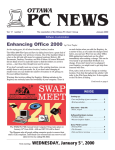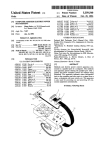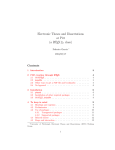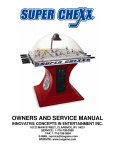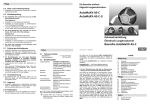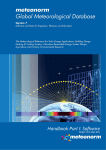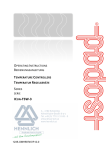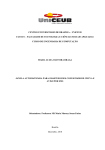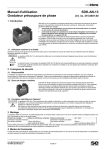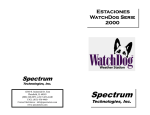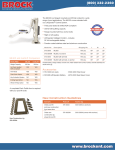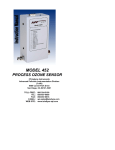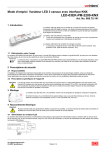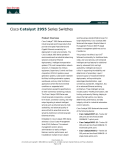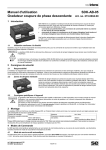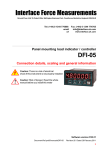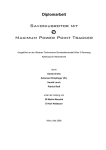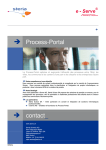Download Documentation - Tech
Transcript
DIPLOMA PAPER DOCUMENTATION Optimization of a High-Temperature Tribometer Diploma Project by Damian Frey and Simon Wüest Project numbers: 4008-S; 4028-S Industrial Customer: EMPA-Thun Mousab Hadad Dr. Johann Michler Project members: Damian Frey Simon Wüest Major: Systems Engineering; 6th semester Project Supervisor: Prof. Jörg Sekler Methodic Coach: Prof. Martin Klöti Project website: tech.wueest.name/tribometer Date: Windisch, August 15th 2008 Version Table Version 1.0 1.1 Damian Frey Simon Wüest Changes first draft various corrections and complements Date August 04th 2008 August 14th 2008 I/3 High-Temperature Tribometer AbstractI At EMPA-Thun several tribometers are used to analyse material abrasion. In the context of a twosemesters project at the University of Applied Science of Northwestern Switzerland an existing tribometer for so-called “block-on-ring” experiments was modernized concerning data acquisition and device control and upgraded with additional functionality (high temperature experiments). In the first part (fifth study term) the tribometer was completely disassembled for the analysis of the system functions and the evaluation of different possibilities for improvement. The electrical schema of the equipment was noted, since this was missing in the existing documents. The main task in the first part of the project contained the development of different solutions, which allow measurements in room temperature and high temperature experiments. For the determination of empirical friction coefficients of different material combinations the normal force and the friction force must be measured in experiments. Further the temperature and the rotational speed must be measured and regulated at the same time. In the sixth study term (including the diploma work) the solution, confirmed by EMPA, was implemented and the tribometer was taken into operation. Finally some test experiments were done to verify the tribometer. I This text is partly similar with the text from the documentation of the first term project Damian Frey Simon Wüest II / 3 High-Temperature Tribometer Customer Dr. Johann Michler Mousab Hadad Empa (Werkstofftechnologie) Feuerwerkstr. 39 CH-3602 Thun Empa (Werkstofftechnologie) Feuerwerkstr. 39 CH-3602 Thun Email: [email protected] URL: www.empa.ch Email: [email protected] URL: www.empa.ch Project team Damian Frey Simon Wüest Email: [email protected] URL: www.damianfrey.ch Email: [email protected] URL: tech.wueest.name Supervisor Prof. Jörg Sekler Hochschule für Technik Steinackerstrasse 5 5210 Brugg-Windisch Email: [email protected] URL: www.fhnw.ch Coach Prof. Martin Klöti Hochschule für Technik Steinackerstrasse 5 5210 Brugg-Windisch E-Mail: [email protected] URL: www.fhnw.ch Damian Frey Simon Wüest III / 3 High-Temperature Tribometer 1 Content 1 Content ............................................................................................................................................ 1 2 Introduction ..................................................................................................................................... 4 3 4 2.1 Initial situation ....................................................................................................................... 4 2.2 Goals ...................................................................................................................................... 5 2.2.1 Achieved first term project goals....................................................................................... 5 2.2.2 Second term and diploma goals......................................................................................... 5 Tasks and solutions ......................................................................................................................... 6 3.1 Tasks ...................................................................................................................................... 6 3.2 Solutions ................................................................................................................................ 7 3.2.1 Temperature regulation...................................................................................................... 7 3.2.2 Rotation speed control ....................................................................................................... 7 3.2.3 Arbor torque and rotational speed measurement ............................................................... 8 3.2.4 Lever torque....................................................................................................................... 8 The new Tribometer ........................................................................................................................ 9 4.1 Mechanics .............................................................................................................................. 9 4.1.1 General description............................................................................................................ 9 4.1.2 Characteristic frequencies................................................................................................ 13 4.2 Electrics................................................................................................................................ 15 4.3 Schema................................................................................................................................. 16 4.3.1 Power circuit.................................................................................................................... 16 4.3.2 Signal circuit.................................................................................................................... 16 4.3.3 Current measurement....................................................................................................... 17 4.3.4 Darlington driver ............................................................................................................. 17 4.3.5 Terminal block frequency converter................................................................................ 17 4.3.6 Terminal block................................................................................................................. 18 4.3.7 Part list............................................................................................................................. 19 4.4 IO declaration....................................................................................................................... 20 4.4.1 DAQ-Card ....................................................................................................................... 20 4.4.2 Temperature card............................................................................................................. 20 4.5 Analog signal processing ..................................................................................................... 21 4.5.1 Current measurement....................................................................................................... 21 4.5.2 Rotation speed measurement ........................................................................................... 22 4.5.3 Calibration of the force sensors ....................................................................................... 23 4.5.4 High temperature measurement ....................................................................................... 23 4.5.5 Room temperature measurement ..................................................................................... 27 Damian Frey Simon Wüest 1 / 69 High-Temperature Tribometer 4.5.6 Temperature measurement............................................................................................... 30 4.5.7 Analog output .................................................................................................................. 30 4.6 5 6 7 8 Digital signal processing...................................................................................................... 30 4.6.1 Digital inputs ................................................................................................................... 30 4.6.2 Digital outputs ................................................................................................................. 30 Program ......................................................................................................................................... 31 5.1 Documentation..................................................................................................................... 31 5.2 Important.............................................................................................................................. 31 5.3 General architecture ............................................................................................................. 31 5.3.1 Creating a program .......................................................................................................... 31 5.3.2 Run an experiment........................................................................................................... 35 5.3.3 Tools to adjust and calibrate the software ....................................................................... 38 5.3.4 Calibrating the tribometer................................................................................................ 46 5.3.5 Data management system ................................................................................................ 47 5.4 Main VIs .............................................................................................................................. 48 5.5 Hidden functions.................................................................................................................. 48 5.6 Problems .............................................................................................................................. 49 5.6.1 Temperature measurement............................................................................................... 49 5.6.2 Brocken Digital IO 1 ....................................................................................................... 49 5.7 Bugs ..................................................................................................................................... 50 5.8 Optimization ........................................................................................................................ 51 Test experiment ............................................................................................................................. 52 6.1 High temperature experiment............................................................................................... 52 6.2 Room temperature experiment............................................................................................. 54 6.3 Different sampling and saving rates..................................................................................... 56 6.4 Regulation of oven or sample temperature .......................................................................... 58 Problems and their solutions ......................................................................................................... 59 7.1 Shielding .............................................................................................................................. 59 7.2 Heating element and dimmer ............................................................................................... 59 7.2.1 Dimmer............................................................................................................................ 59 7.2.2 Heating element (filament) .............................................................................................. 59 7.3 Temperature measurement................................................................................................... 60 7.4 Installing the room temperature force module..................................................................... 60 7.5 Breakdown of LabVIEW Digital IO 1 ................................................................................. 61 Future tasks.................................................................................................................................... 62 8.1 Damian Frey Simon Wüest Replacement heating element .............................................................................................. 62 2 / 69 High-Temperature Tribometer 8.1.1 Replacement THERMOCOAX filament ......................................................................... 62 8.1.2 Ceramic heating element ................................................................................................. 62 8.1.3 Other possibilities ............................................................................................................ 62 8.2 Formula for idle torque correction ....................................................................................... 63 8.3 Formula for normal force error in function of the oven temperature................................... 63 8.4 Fixation of the oven temperature sensor .............................................................................. 63 8.5 Mechanical damping of the motor support .......................................................................... 63 8.6 Alignment of the rotating arbor ........................................................................................... 63 8.7 Test security coupling .......................................................................................................... 63 8.8 Cover for the rotating elements (security) ........................................................................... 64 8.9 Oil leakage ........................................................................................................................... 64 8.10 Test the reliability of the tribometer .................................................................................... 65 8.10.1 9 Counter problems ........................................................................................................ 65 8.11 Program optimization........................................................................................................... 65 8.12 Temperature monitoring of the room temperature force module......................................... 65 Addendum ..................................................................................................................................... 66 9.1 Glossary ............................................................................................................................... 66 9.2 List of illustrations ............................................................................................................... 67 Damian Frey Simon Wüest 3 / 69 High-Temperature Tribometer 2 IntroductionII 2.1 Initial situation The Federal Institute for Material Science and Technology (EMPA) uses – at its branch in Thun - a device to determine the specific abrasion properties of two samples rubbing on each other. In the experiments, a ring and a block are used for this tribometer test. Firstly, the parts are cleaned, weighted and then installed in the machine. The ring is turned at a given speed for a given time or distance, while the block is pressed against the rotating ring. The test chamber can be heated up to 700 °C. After the experiment, the parts are cleaned and weighted again, in order to determine the mass loss due to friction and consequent abrasion. In a former diploma projectIII, realized by Martin Stettler of the University of Applied Science in Burgdorf, an additional device has been developed and installed. The device allows measuring the friction force as well as the normal force during an experiment. This enables the user making a conclusion of the coefficient of friction. The motor, to rotate the probe, is controlled (on/off) by a LabVIEW application. The data acquisition is also done using the same software, which allows to print protocols and to export the data for further analysis (e.g. MS-Excel). Unfortunately with the new device installed, the oven cannot be heated up anymore. For experiments with high temperature requirements, the new test device has to be removed. Furthermore the temperature and the rotation speed of the motor are not automatically controlled and have to be regulated by hand. In addition the oven does not heat up properly anymore. Ill. 1: Complete tribometer II III Ill. 2: Tribometer with the top cover removed This text is partly similar with the text from the documentation of the first term project Instrumentierung und Inbetriebnahme des tribologischen Prüfgerätes „Tribomat“, Bericht zur Diplomarbeit von Martin Stettler Hochschule für Technik und Architektur Burgdorf, Abteilung Elektrotechnik EMPA Eidgenössische Materialprüfungs- und Forschungsanstalt 25.10.1999 bis 17.01.2000 Damian Frey Simon Wüest 4 / 69 High-Temperature Tribometer 2.2 Goals 2.2.1 Achieved first term project goals Because the overall project goals exceeded the possibilities of a one semester project, the goals are distributed in two term projects. In the first term project the device had to be analyzed first to answer the following points: 1. Which components do still work? 2. Which components have to be replaced? 3. Which components have to be repaired? 4. Which components can be left away or replaced. 5. How can the physical values for the experiments (temperature, friction force, normal force, rotation) be measured correctly? 6. What new devices or parts have to be build or bought? On the basis of this analysis several solutions have been developed. For each solution the advantages and the disadvantages, as well as the effort in terms of cost and labor were estimated. A preliminary estimation of the required budget has been made available before the end of 2007. After the presentation of the different solutions, we got clearance to buy the required materials and started implementing the selected solution. 2.2.2 Second term and diploma goals The entire tribometer has to be reassembled. Additional sensors have to be integrated into the system, which will allow measuring the temperature (near the probes), the friction force, the normal force and the true rotation speed of the probe (ring). All experiments should be controlled from a single user interface; in particular turning on and off the motor (to rotate the probes) and the heating of the oven. The temperature has to be controlled automatically. This includes monitoring the temperature for eventual excessive overheating problems and emergency shut downs as well. The interface should allow the user to program temperature changes during the experiment (e.g. linear increase of the temperature form 20 °C to 700 °C). A control for a preselected rotation speed has to be installed as well. The gathered data (temperature, friction force, normal force, rotation speed) have to be protocolled and stored automatically, so they can be used for further analysis. Optionally, a software tool can be programmed, which already preprocesses the routine analysis work. In a final phase of the project various experiments will be run on the machine. Particularly specimens with micro- and nanocomposites and -coatings are of special interest. Damian Frey Simon Wüest 5 / 69 High-Temperature Tribometer 3 Tasks and solutionsIV 3.1 Tasks The main tasks to be solved are listed below: 1. Temperature regulation The temperature in the test chamber or the sample temperature is to be regulated by LabVIEW. Either a constant temperature (usually) or a desired ramp is given. 2. Rotation speed control Until now, the rotation speed was controlled manually. An automatic regulation of the rotational speed is preferable. 3. Arbor torque and rotational speed measurement The dynamic torque as well as the rotational speed at the arbor, which rotates the ring-sample, are to be measured and plotted by LabVIEW. 4. Torque measurement at the lever The static torque at the lever, which presses the block-sample onto the ring-sample, is to be measured and plotted by LabVIEW. 5. LabVIEW program and user interface The LabVIEW program has to acquire all measured data and write them in a *.csv-file, which allows interpreting the data with Microsoft-Excel or a similar program. Furthermore it should be possible to program different experiments and to simply recall them for repeated use. IV This text is partly similar with the text from the documentation of the first term project Damian Frey Simon Wüest 6 / 69 High-Temperature Tribometer 3.2 Solutions 3.2.1 Temperature regulation EMPA-Thun already used a rack for thermocouples from National Instruments (Type: TC-2190) including the matching DAQ-PCI-Card. We decided to reuse this module because it is easy and accurate enough. Two temperature sensors (Type K) are used. One measures the temperature near the probe and the other in the oven environment. The temperature signals are acquired by LabVIEW. This information should be protocolled and further be used to regulate the temperature in the oven. To do so, LabVIEW controls a dimmer (0-10VDC), which sets the heating current. The dimmer already exists. Until now the heating current was controlled with a potentiometer. Additional temperature sensors are installed as well to monitor the strain gauges measuring bridge and the torque sensor temperature. Advantages: • Cheap and simple • No additive components are necessary Disadvantages: • Old components (dimmer is not available anymore if it needs to be replaced) Ill. 3: Dimmer varintens LE-16 Ill. 4: Temperature module NI TC-2190 3.2.2 Rotation speed control For the automatic rotational speed control, a frequency converter has to be connected to the motor. Several frequency converters have an input ratio between 0 and 10VDC so they easily can be controlled with LabVIEW. For this solution a rotational speed feedback is required (see 3.2.3). The maximum acceleration is limited by the settings of the frequency converter (see user manual). Advantages: • Rotational speed control with LabVIEW • Possible to change rotational speed during an experiment (e.g. ramp) Disadvantages: • Costs about 750 CHF • Another consumer of electricity Ill. 5: Frequency converter Hitachi L200 Damian Frey Simon Wüest 7 / 69 High-Temperature Tribometer 3.2.3 Arbor torque and rotational speed measurement The dynamic torque is detected with a dynamic torque sensor, without rotation speed sensor. The rotational speed is detected with an incremental encoder. Advantages: • Torque can easily be detected and evaluated with LabView. • Rotational speed can easily be acquired with LabVIEW. Disadvantages: • Additional support for the torque sensor and the incremental sensor has to be constructed. • Rather expensive (T22 from HBM ca. 4’050 CHF) Ill. 6: Dynamic torque sensor Ill. 7: Incremental encoder 3.2.4 Lever torque As we dismounted the lever, which presses the block-sample against the ring, we realized four strain gauges were already applied to the arbor. They did not work anymore because the strain gauges and the wires connecting them got brittle and partly broke. We decided to simply replace them. The replacement was done by the company HBM, they also mounted a temperature sensor near the strain gauges, to observe the temperature of the strain gauges, they work up to 200 °C. Advantages: • Space saving measurement • Stands temperatures up to 200 °C Disadvantages: • Calibration is necessary Ill. 8: Strain gauges on the lever Ill. 9: Carrier frequency amplifier KWS 503C Damian Frey Simon Wüest 8 / 69 High-Temperature Tribometer 4 The new Tribometer The datasheets and user manuals are on the project CD. They are in the folder "datasheets". 4.1 MechanicsV From the three solutions described in the first term project documentation, we chose in agreement with the customer to realize the “adequate” solution. It is therefore documented here more detailed and concrete 4.1.1 General description The basic idea to measure the torque precisely, is to mount the torque sensor as close to the probe as possible. Since the torque sensor cannot stand the heat, we had to mount the senor outside the oven, right after the oil feed system. In Ill. 11 the torque sensor is shown in light green. The arbor used to be driven over a V-belt form the motor, which was mounted in the support. This is not possible anymore, since the torque sensor uses up to much space. Therefore we had to find a new way, how to bring the rotation from the motor onto the arbor. One possibility is to keep the motor in the support (where it was) and bring the radiation over V-belt or a chain and a rather complicated redirection device to the arbor. With this solution it will be very complicated to predict the behavior and to determine the characteristic frequencies, because the rotation and the forces are passed through many parts. Ill. 10: Schema of the old system The idea to solve this problem is to simplify the system as much as possible. A more simple solution, than the one described above is to extend the arbor of the motor, so it will reach the outside of the support (through a hole). From here the rotation can be brought directly to the torque sensor over a Vbelt or a chain, since we now got enough space to get behind the torque sensor with a belt. The problem with belts and chains is that their elastic behavior is difficult to determine and to predict. To V This text is partly similar with the text from the documentation of the first term project Damian Frey Simon Wüest 9 / 69 High-Temperature Tribometer avoid elastic behavior we could use stiffer parts (e.g. gear). But there again: these parts have backlash, which are also not wanted in our system. The simplest solution is to mount the motor directly to the torque sensor. This way we can avoid complicated behavior in characteristic frequencies. The downside of this solution is that vibrations of the motor will be passed directly onto the torque sensor. An elastic element could filter out the motors vibrations. As described above we do not want to use elastic elements, because their behavior and the impact on the system are difficult to predict. If vibrations form the motor should be a problem the motor can be decoupled from the torque sensor with a rotating mass between the motor and the torque sensor. With an additional mass the system will lose some of its dynamics. This is not further a problem, since the experiments are run at a constant rotational speed. The last solution described above is schematically drawn in Ill. 11. The motor (indicated in dark green) is mounted directly to the torque sensor. Since the motor will be controlled with a frequency converter, the various gear is not needed anymore. Because of the missing gear the motor will turn considerably slower than before for a long time. The motor is self cooled, so the possibility of overheating is quite high. To avoid heat damage to the motor, a separate ventilator is installed, which will guaranty constant air cooling. force lever couplings motor torque sensor oil feed rotary encoder oven Ill. 11: Schema of the new system The rotational speed of the arbor is measured with a rotary encoder (also indicated in light green). The encoder is driven synchronously with a toothed belt from the arbor. Since this construction will overlap the size of the current tribometer quit a bit, an additional support (shown in Ill. 12) had to be built to the machine, to hold the motor and the torque sensor. Damian Frey Simon Wüest 10 / 69 High-Temperature Tribometer Ill. 12: Schema of the new system with complete support The force in the force lever is measured with four strain gauges. They are glued in the thin part on the axis indicated in light green in Ill. 14. The strain gauges can stand temperature up to 200 °C. Since the strain gauges are already in the cooled part of the back door, there should not be any overheating problems. To avoid possible damage, due to overheating, a thermocouple measures the strain gauges temperature. If necessary this allows taking immediate actions during an experiment. The strain gauges are evaluated with a carrier frequency measurement amplifier. EMPA already used such an amplifier built by the company HBM. We reused this amplifier, but we have to keep in mind that the amplifier is quit old and HBM does not provide any support or guaranty. The temperature in the oven is measured with two thermocouples. One thermocouple is mounted near the probe to measure the probe temperature. The other measures the temperature of the ovens atmosphere. torque sensor arbor coupling motor Ill. 13: The arbor, the torque sensor and the motor aligned in one line All the housing is removed in this image so it can be seen how the arbor and the torque sensor is aligned in one line to simplify the system as much as possible. Damian Frey Simon Wüest 11 / 69 High-Temperature Tribometer Ill. 14: Parts measuring physical values The measuring parts are shown in light green. From left to right: Normal force, friction force (torque sensor), rotational speed (encoder) Ill. 15: Back door with the parts running through it For additional security we installed a security coupling (EAS-compact Type 01/493.530.0, from mayr Kupplungen AG, www.mayr.de, shown in Ill. 16) instead of the coupling between the dynamic torque sensor and the motor. It protects the dynamic torque sensor from being destroyed if an unexpected blocking either of the motor or the arbour occurs. If the security coupling separates the drive train from the motor, a contactless end switch (Type 055.001.5 230 VAC) detects the stroke of the security coupling and sets LabVIEW Digital IO 6 to low. Ill. 16: Security coupling EAS-compact Type 493.530.0 Damian Frey Simon Wüest 12 / 69 High-Temperature Tribometer 4.1.2 Characteristic frequencies During the first experiments we realized that the motor support starts to vibrate at distinct frequencies of the motor. We could borrow a gravitation sensor. We mounted it onto various parts of the tribometer and recorded the vibration in relation to the motor speed. The sensor records the acceleration in x, y and z directions. Be aware that this diagram does not show the amplitude (the distance) but the acceleration of the sensor! The x, y and z directions are those of the sensor, not of the tribometer, that is why the offset of the measured acceleration [g] is not equal in the diagrams. characteristic frequencies measured on the motor 2 1.5 a [g] 1 0.5 0 0 500 1000 1500 2000 2500 3000 -0.5 -1 -1.5 n [rpm] x y z Ill. 17: Characteristic frequencies of the motor characteristic frequencies measured on the dynamic torque sensor 4 3 2 a [g] 1 0 0 500 1000 1500 2000 2500 3000 -1 -2 -3 -4 n [rpm] x y z Ill. 18: Characteristic frequencies on the dynamic torque sensor Damian Frey Simon Wüest 13 / 69 High-Temperature Tribometer characteristic frequencies measured on the electric control box 1.5 1 a [g] 0.5 0 0 500 1000 1500 2000 2500 3000 2500 3000 -0.5 -1 n [rpm] x y z Ill. 19: Characteristic frequencies on the electric control box characteristic frequencies measured on the oven tube 1.4 1.2 1 0.8 a [g] 0.6 0.4 0.2 0 -0.2 0 500 1000 1500 2000 -0.4 -0.6 n [rpm] x y z Ill. 20: Characteristic frequencies on the oven tube It is advisable to avoid running experiments with continuous operation with motor speeds around these characteristic frequencies. As shown in the above diagrams the characteristic frequencies are: • • • • Between 450 and 550 rpm Between 900 and 1250 rpm Between 1750 and 1900 rpm Between 2200 and 2450 rpm Damian Frey Simon Wüest 14 / 69 High-Temperature Tribometer 4.2 Electrics The most remarkable change in electrics is the supply for the motor. The rotation speed is now controlled by the frequency converter instead of the manual gear. The frequency converter is controlled with LabVIEW. The Dahlander switch S2 defines the maximum speed of the motor. It sets the motors windings either to a triangular or double star circuit (max. 1500 rpm / 3000 rpm). Due to the new principle of measurement, the tribometer contains various additional sensors and other components. The sensors power supply is an AC/DC converter with ±15VDC. Some switches are not needed anymore or were replaced by the functionality of the LabVIEW implementation. The interface terminal between the tribometer and the LabVIEW data acquisition card is placed in an aluminum box at the side of the tribometer. Four D-Sub jacks (15 poles) connect the box with the corresponding electrical components of the tribometer. The terminal is connected to the LabVIEW data acquisition card with one single cable. Ill. 21: Interface terminal box To prevent the tribometer from damage, some security features are implemented by the hardware: • It is not possible to start the motor without the oil pump running (S3). • It is not possible to heat up the oven without water cooling turned on (S7). The denomination numbers of the parts in the electrical schema are not always progressive, because we did not renumber the parts after the modernization. Some parts have kept their denominations from the old schema. Damian Frey Simon Wüest 15 / 69 High-Temperature Tribometer 4.3 Schema 4.3.1 Power circuit Ill. 22: Power circuit 4.3.2 Signal circuit Ill. 23: Signal circuit Damian Frey Simon Wüest 16 / 69 High-Temperature Tribometer 4.3.3 Current measurement Ill. 24: Current measurement multiplexer current measurement 4.3.4 Darlington driver Ill. 25: Darlington driver 4.3.5 Terminal block frequency converter Ill. 26: Terminal block frequency converter Damian Frey Simon Wüest 17 / 69 High-Temperature Tribometer 4.3.6 Terminal block Ill. 27: Terminal block X3, X4, X5, X6 and Pinout NI terminal block X7 Damian Frey Simon Wüest 18 / 69 High-Temperature Tribometer 4.3.7 Part list Label Name Distributor / Type B1 B2 B3 B4 B5 B6 current meter (hall sensors) multiplexer operating hours meter Darlington driver end switch security coupling incremental encoder LEM HX 15-P MPC509A AEG LZ 4 ULN2803A (88509) Mayr 055.001.5 Kübler 05.2400.1122.0500 F1 F2 F3 motor-circuit switch circuit breaker circuit breaker CT 1-10 Weber LS LG 6A Weber LS LG 15A H1 H3 H4 lamp signal lamp signal lamp fluorescent lamp 30cm Luxram 220-260V 7-10W 573 Luxram 220-260V 7-10W 573 K1 K2 K11 K12 electric contactor electric contactor relay relay Sprecher&Schuh CA1-16 Sprecher&Schuh CA1-16 finder LR26716 300V 12A 95.85.1 finder LR26716 300V 12A 95.85.1 M1 M2 M3 M4 motor ventilator pump ventilator motor cooling Bauknecht RF 1.1/4-72 Amphenol-Tuchel electronics XR01 Unitec SK5 56 B4 Pabst 4412F RH resistor filament 10 Ohm S1 S2 S3 S4 S5 S7 turn-switch selector switch turn-switch selector switch light switch for lamp H1 water watcher (switch) CMC Tp10h Kraus&Naimer CA10 7AR198-600E Kraus&Naimer CG8 A203 Kraus&Naimer C10 A441 T1 T2 T3 T4 T5 transformator dimmer DC power supply frequency converter voltage regulator O.Dür ZF 612141 380/150V varintens LE16 PULS ML30.106 Hitachi L200 LM7805CV X1 X2 X3 X4 X5 X6 X7 X8 X9 X10 X11 X12 X13 terminal block terminal block D-Sub jack D-Sub jack D-Sub jack D-Sub jack NI terminal block terminal current measurement jack dynamic torque sensor T22 D-Sub jack carrier frequency amp CH3 terminal frequency converter D-Sub jack carrier frequency amp CH2 D-Sub jack carrier frequency amp CH1 S&S VR2-2.5 / VR1-6 S&S VR1-6 15 pole 15 pole 15 pole 15 pole CB-68LP X8a=with multiplexer; X8b=without multiplexer transducer connection cable no. 3-3301.0158 25 pole Hitachi L200 25 pole 25 pole Damian Frey Simon Wüest TechnoKontrol 19 / 69 High-Temperature Tribometer 4.4 IO declaration Outputs Inputs 4.4.1 DAQ-Card IO number Analog Input 0 Analog Input 1 Analog Input 2 Analog Input 3 Analog Input 4 Analog Input 5 Analog Input 6 Analog Input 7 IO name Fn M Fn2 (Room temperature force module) Ft2 (Room temperature force module) Motor fast / slow Current R Current S Current T PIN 68 33 65 30 28 60 25 57 PIN GND 34 66 31 63 61 26 58 23 Motor on / off Motor slow/fast (broken) Motor direction (clockwise / anti clockwise) Water on / off Tribometer has power Error frequency converter Error coupling 52 17 49 47 19 51 16 8 (5V) 14 (5V) 8 (5V) 14 (5V) 14 (5V) 14 (5V) Counter Input 0 Counter Input 1 Incremental encoder 37 42 4 4 Analog Output 0 Analog Output 1 Heating Motor (frequency converter 22 21 55 55 Digital IO 7 Motor on / off (Darlington driver K11) 48 9 (GND); 8 (5V) Digital IO 0 Digital IO 1 Digital IO 2 Digital IO 3 Digital IO 4 Digital IO 5 Digital IO 6 4.4.2 Temperature card Temperature Channel 02 Sample temperature Temperature Channel 03 Oven temperature Temperature Channel 04 Strain gauges temperature Temperature Channel 05 M-Sensor temperature Temperature Channel 06 Temperature Channel 07 Temperature Channel 08 Temperature Channel 09 Temperature Channel 10 Temperature Channel 11 Temperature Channel 12 Temperature Channel 13 Temperature Channel 14 Temperature Channel 15 Damian Frey Simon Wüest 20 / 69 High-Temperature Tribometer 4.5 Analog signal processing 4.5.1 Current measurement Analog Input 5 → current phase R Analog Input 6 → current phase S Analog Input 7 → current phase T Current is measured with three Hall sensors LEM HX 15-P characteristic curve I 18 16 14 I [A] 12 10 8 6 4 2 0 0.00 0.50 1.00 1.50 2.00 2.50 3.00 3.50 4.00 4.50 U [V] current (I = 15 / 4 * U) Ill. 28: Characteristic curve current Damian Frey Simon Wüest 21 / 69 High-Temperature Tribometer 4.5.2 Rotation speed measurement Counter Input 1 → rotation speed Rotation speed is measured with an incremental encoder (500 pulses per 360°) characteristic curve n 3500 3000 n [rpm] 2500 2000 1500 1000 500 0 0 5000 10000 15000 20000 25000 30000 impulses per second [Hz] rotation speed (n = 60 / 500 * f) Ill. 29: Characteristic curve rotation speed Damian Frey Simon Wüest 22 / 69 High-Temperature Tribometer 4.5.3 Calibration of the force sensors To calibrate the force sensors we measure the output voltages of the carrier frequency amplifier and wrote them with the corresponding load forces in a table (please note that the channels of the carrier frequency amplifier must be calibrated as well, the settings are noted near the characteristic curves). We increased the load stepwise (1 kg per step). The data points were converted to an approximate linear function with the MATLAB function “polyfit”. 4.5.4 High temperature measurement 4.5.4.1 Normal force Analog Input 0 → high temperature normal force To calibrate the normal force strain gauges measuring bridge, a precise balance is needed to measure the load. To retain the exact geometries of the fully installed tribometer it is important to install the balance exactly where the ring sample is normally installed. Carrier frequency amplifiers channel 3 settings for calibration: • Set the basic parameter of the measuring range to 0.2 mV/V • Set the output voltage to 0.0 V with the unloaded lever (R balance) • Note that the modulation must not exceed the critical level with maximum load (C balance) characteristic curve Fn high temperature with basic parameter 0.2 250.00 Fn [N] 200.00 150.00 100.00 50.00 0.00 0.000 1.000 2.000 3.000 4.000 5.000 6.000 7.000 U [V] measured normal force calculated normal force (Fn = 35.98439 * U - 3.42451) Ill. 30: Characteristic curve high temperature normal force with basic parameter 0.2 Damian Frey Simon Wüest 23 / 69 High-Temperature Tribometer During the first experiments we realized that the normal force increases with the rotating arbor. Due to this fact, the modulation of the carrier frequency amplifiers channel 3 exceeded the critical level. We had to change the basic parameter of the measuring range from 0.2 to 0.5 mV/V. Therefore we had to ascertain another formula for this calibration (shown in Ill. 31). Carrier frequency amplifiers channel 3 settings for calibration: • Set the basic parameter of the measuring range to 0.5 mV/V characteristic curve Fn high temperature with basic parameter 0.5 250.00 Fn [N] 200.00 150.00 100.00 50.00 0.00 0.000 0.500 1.000 1.500 2.000 2.500 3.000 U [V] measured normal force calculated normal force (Fn = 86.79355 * U - 1.71267) Ill. 31: Characteristic curve high temperature normal force with basic parameter 0.5 Another problem is that the geometries of the lever force change and the measured voltage decreases with the increasing oven temperature. Therefore we measured the normal force error in relation to the oven temperature. We loaded the lever with a constant load and heated up the oven. We recorded the measured normal force and the oven temperature. Damian Frey Simon Wüest 24 / 69 High-Temperature Tribometer The measured normal force must be corrected with the formula shown in Ill. 32. It is implemented in the LabVIEW program but the formula is only correct between 30 and 410 °C, due to the measured temperature range (maximum temperature with the provisionally repaired heating element, see point 7.2.2). Therefore it is advisable to correct the formula by running this experiment again with a wider temperature range (8.3). Fn [N] error in relation to T [°C] 200 150 Fn [N] 100 50 y = 7E-07x3 - 0.0008x2 + 0.1007x - 5.3268 0 20 70 120 170 220 270 320 370 -50 -100 T [°C] Fn with 4kg load Fn with 8kg load error Fn 4kg load error Fn 8kg load Polynomisch (error Fn 4kg load) Ill. 32: Fn error in function of the oven temperature corrected normal force in function of the oven temperature 80 70 60 Fn [N] 50 40 30 20 10 0 -10 20 70 120 170 220 270 320 370 oven temperature [°C] corrected Fn measured Fn error Fn Ill. 33: Corrected Fn in function of the oven temperature Damian Frey Simon Wüest 25 / 69 High-Temperature Tribometer 4.5.4.2 Dynamic torque Analog Input 1 → high temperature dynamic torque To calculate the tangential force from the dynamic torque M, the diameter of the ring-sample is needed. characteristic curve M 6 5 M [Nm] 4 3 2 1 0 0 1 2 3 4 5 6 U [V] dynamic torque (M = U) Ill. 34: Characteristic curve high temperature dynamic torque When the tribometer is not loaded, an idle torque can be measured which depends on the rotation speed. To compensate the idle torque we used a logarithmic formula as shown in Ill. 35. We repeated the experiment (yellow line) to evaluate the error (red line) of the compensation. For a more accurate compensation some more idle torque measurements are necessary (8.2). 0.6 y = 0.096Ln(x) - 0.2498 0.5 torque M [Nm] 0.4 0.3 0.2 0.1 0 0 500 1000 1500 2000 2500 3000 3500 -0.1 rotation speed [rpm] idle reference torque M [Nm] idle torque M [Nm] idle torque M error [Nm] Logarithmisch (idle reference torque M [Nm]) Ill. 35: Idle torque compensation Damian Frey Simon Wüest 26 / 69 High-Temperature Tribometer 4.5.5 Room temperature measurement 4.5.5.1 Normal force Analog Input 0 → high temperature normal force Due to the different geometries with the room temperature force module installed, the strain gauges measuring bridge has another characteristic curve for the normal force. The corresponding load of the output voltages (carrier frequency amplifier) are measured with the already calibrated room temperature force module and calculated with its characteristic linear function. Carrier frequency amplifiers channel 3 settings for calibration: • Set the basic parameter of the measuring range to 0.5 mV/V characteristic curve Fn room temperature 200.00 180.00 160.00 140.00 Fn [N] 120.00 100.00 80.00 60.00 40.00 20.00 -1.000 0.00 0.000 1.000 2.000 3.000 4.000 5.000 U [V] measured normal force calculated normal force(Fn = 36.80005 * U + 3.99248) Ill. 36: Characteristic curve high temperature normal force, with room temperature force module Damian Frey Simon Wüest 27 / 69 High-Temperature Tribometer Analog Input 2 → room temperature normal force Ill. 37: Calibration of the room temperature normal force Carrier frequency amplifiers channel 2 settings for calibration: • Set the basic parameter of the measuring range to 2 mV/V • Set the output voltage to 0.0 V with the unloaded module (R balance) • Note that the modulation must not exceed the critical level with maximum load (C balance) characteristic curve Fn2 140.00 120.00 Fn2 [N] 100.00 80.00 60.00 40.00 20.00 0.00 0.000 0.500 1.000 1.500 2.000 2.500 3.000 3.500 4.000 4.500 U [V] measured normal force calculated normal force (Fn2 = 28.32117 * U - 1.29924) Ill. 38: Characteristic curve room temperature normal force Damian Frey Simon Wüest 28 / 69 High-Temperature Tribometer 4.5.5.2 Tangential force Analog Input 3 → room temperature tangential force Ill. 39: Calibration of the room temperature tangential force Carrier frequency amplifiers channel 1 settings for calibration: • Set the basic parameter of the measuring range to 1 mV/V • Set the output voltage to 0.0 V with the unloaded module (R balance) • Note that the modulation must not exceed the critical level with maximum load (C balance) characteristic curve Ft2 140.00 120.00 Ft2 [N] 100.00 80.00 60.00 40.00 20.00 0.00 0.000 0.500 1.000 1.500 2.000 2.500 3.000 U [V] measured tangential force calculated tangential force (Ft2 = 44.60995 * U - 0.01965) Ill. 40: Characteristic curve room temperature tangential force Damian Frey Simon Wüest 29 / 69 High-Temperature Tribometer 4.5.6 Temperature measurement Temperature Channel 02 → sample temperature Temperature Channel 03 → oven temperatures Temperature Channel 04 → strain gauge temperatures Temperature Channel 05 → dynamic torque sensor temperatures 4.5.7 Analog output 4.5.7.1 Filament heating control Analog Output 0 → control input dimmer The control input of the dimmer (0 – 10VDC) sets the heating current (0 – 16A), which determines the heating power (0 – 2560W). 4.5.7.2 Frequency converter control Analog Output 1 → control input frequency converter The control input of the frequency converter (0 – 10VDC) sets the frequency of the motor power supply (0 – 50Hz), which determines the rotation speed (0 – 1500rpm or 0 – 3000rpm, depending on the status of the speed selector switch S2). 4.6 Digital signal processing 4.6.1 Digital inputs Digital IO 0 → motor on / off (high when contactor K1 on) Digital IO 1 → Digital IO 1 broke down (see 7.5) Digital IO 2 → motor selector clock- / anti clockwise (low when S4 on 0, else high) Digital IO 3 → heating filament on / off (high when contactor K2 on) Digital IO 4 → machine power on / off (high when machine power on) Digital IO 5 → error frequency converter (low when error occurs) Digital IO 6 → error security coupling (low when error occurs) 4.6.2 Digital outputs Digital IO 7 → Damian Frey Simon Wüest motor on / off (high sets K11 on, K11 sets K1 on) 30 / 69 High-Temperature Tribometer 5 Program 5.1 Documentation In this document only a rough overview over the software architecture is written. Most of the documentation is directly written in the LabVIEW program code. In the code lots of small notes briefly describe what is done. Each VI is documented with a short description of what is done. All the visible controls and indicators on the GUIs have a context help entry. This description is designed to interactively inform the user. 5.2 Important The tribometer software runs on MS-Windows. Windows is actually not designed for real time application. Opening programs, scrolling or switching tabs may use up to much resources and the tribometer application cannot keep up with some tasks in time. So try not to use the computer for other tasks while running an experiment. We even recommend you not to switch between windows or scroll in a window. 5.3 General architecture The software can be divided into four major parts: • • • • User interfaces to create programs Functions to run experiments Tools to adjust and calibrate the software Data management system to manage the programs and the experiments (in dossiers) 5.3.1 Creating a program To run an experiment the user first needs to create a program. A program consists of several steps. The program executing software works consecutively through these steps. In a step the following can be determined: • • • • • • • Temperature rise and fall Speed rise and fall Wait until a certain time is over Wait until the ring samples surface scratched a certain distance on the block sample Start and stop measuring Breakpoint (wait until the user clicks on “continue”) The switching condition which must be achieved so the next step can be loaded Usually the programmed parameters are also relevant for the switching condition. For example when the temperature should rise to 500 °C the program will switch to the next step as soon as the temperature reaches 500 °C (plus/minus the tolerance). Damian Frey Simon Wüest 31 / 69 High-Temperature Tribometer For each step three sets of parameters can be defined. The switching conditions can be a combination of one, two or all three sets of parameters. For example: • • • • • Heat up to 500 °C and speed up to 7 m/s. Switch to the next step if both (AND) target values are achieved. Heat up 500 °C and wait for 10 minutes. Switch to the next step if the temperature reaches 500 °C OR the time is up. Wait for 5 seconds and speed up to 3 m/s. Switch to the next step when the time is up no matter if the target speed was achieved or not. Heat up to 500 °C, speed up to 7 m/s and wait until 1 km distance is over. Switch to the next step if all three (AND) target values are achieved. etc. To each step the user can provide a step name. If the user uses precise expressing names the program can be easy read. To the actual program the user can provide a series of addition information: To each program a program name and a description can be entered. Usually with one program the same or similar samples are testes. To save the user typing work, some information about the sample (such as material, density, diameter, etc.) can already be provided at this level. This information will be loaded with the program when an experiment is run. If necessary the operator can then still make some adjustments. The program with all the additional information finally has to be saved. The software will create four separate files with the same name but different file extensions. It is therefore recommended to use an extra folder for each program. Ill. 41: User interface to create a program step Damian Frey Simon Wüest 32 / 69 High-Temperature Tribometer 5.3.1.1 Simple program The above described programming interface is very flexible but for most experiments not very comfortable, because quite a few steps have to be create for a simple standard program. Simple standard programs work through the following steps: 1. 2. 3. 4. 5. 6. 7. 8. Heat up to a certain temperature (if it is not a room temperature experiment) Set a breakpoint Start measuring Speed up the motor to a given speed Wait until a certain time or distance is over Stop the motor Stop measuring Turn off the heating (if it is not a room temperature experiment) Instead of a normal program the user also can create a simple program which contains just the above listed steps. The entire program can be created in one single user interface. On this graphical interface an approximation of the total time and the total distance is shown. Ill. 42: User interface to create a simple program Damian Frey Simon Wüest 33 / 69 High-Temperature Tribometer 5.3.1.2 Simulation To check if the program actually does what it is supposed to, it can be simulated. A numerical simulation of the tribometer can simulate the expected temperature, speed and forces. Expect for simple program it is recommended to simulate programs prior using them for experiment. Ill. 43: User interface to simulate a program Damian Frey Simon Wüest 34 / 69 High-Temperature Tribometer 5.3.2 Run an experiment The software works through the following steps: 1. Load the general software settings form the default configuration file. 2. Ask the user for the paths to a program and a working directory. All information about the experiment and the acquired data are saved in the working directory. The working directory can also be provided by the experiment management system. See 5.3.5 for more information. 3. Copy the program and the configuration file with the settings to the working directory. 4. Load the program. 5. The header to the report is now created. The user is asked to enter various information about the samples and the experiment such as experiment name, experiment description, sample material, sample weight and so on. The most important information here is the ring samples diameter. It is used to calculate the surface speed of the rotating ring sample during the experiment. 6. To ensure a correct startup of the machine a user interface pops up which guides the user through the startup procedure: a. Install the samples b. Configure the remote temperature measuring computer c. Switch on the carrier frequency amplifier and test the force sensors d. Startup the tribometer until it is fully functional. The different switches on the tribometer have to be turned on in the correct order. e. Test the incremental encoder (speed sensor) f. Test the current sensors g. Check if the coupling or the frequency generator report an error 7. Now the software works through the program step by step until the program is done. See 5.3.2.1 for more details. 8. The window with the header information for the report pops up again. The user may adjust the previous entered information or provide new information like the samples weight after the experiment. 9. Finally a HTML report about the experiment is created. It contains all relevant information: • Experiment and sample information provided by the user • The program which was run • The software settings at the time the experiment was run • The machine protocol which was created during the experiment • Some rough graphs from the temperature, the speed and the friction coefficient • A link to the *.csv file with the acquired data. Damian Frey Simon Wüest 35 / 69 High-Temperature Tribometer Ill. 44: User interface to run an experiment 5.3.2.1 Control and acquire The key part of the software is the tribometer control and the data acquisition. This is realized with a few parallel threads which all handle a specific task: 5.3.2.1.1 Compute the target values and control the tribometer This thread makes sure the tribometer behaves just like the operator programmed the experiment. First it loads the current step and then computes the target temperature and the target speed. Then it sets the output control signals for the heating and the frequency converter (motor). The output signals are computed with PID-controllers depending on the target values with actual speed and temperature. Finally this thread checks if the conditions are met to load the next step. 5.3.2.1.2 Measure the speed and the elapsed distance The speed and the distance are measured with an incremental encoder and a counter port on the data acquisition card (form National Instruments). The incremental encoder returns 500 impulses for each complete turn of the motor. The counter continuously counts the impulses. The software frequently reads the number of counted impulses. With the count difference and the time difference the speed is calculated. The total number of impulses can be converted into the total elapsed distance the ring samples surface scratched on the block sample. To make this calculation the ring samples diameter has to be known. 5.3.2.1.3 Listen for new temperature values The temperature is measured on a second remote computer which frequently sends back the new temperature values over the local area network (TCP). A thread continuously listens for new temperature updates from the remote computer. Damian Frey Simon Wüest 36 / 69 High-Temperature Tribometer 5.3.2.1.4 Data sampling This is the most frequently repeated thread. It measures a sample of all forces and bundles them together with the temperature values and the speed to a single data point. The data points are then written to a first in first out (FIFO) queue. The data points are further used by the data saving thread. 5.3.2.1.5 Data saving With a distinct frequency the enqueued data points are flushed and the data is prepared to write to a file. For each force channel, temperature channel and the speed the mean value is calculated. In addition the mean, the maximum and minimum value of the friction coefficient are determined. The compressed and processed data is once again bundled with a timestamp to a single data point and written to another queue. 5.3.2.1.6 Writing data to file This low priority thread waits for new enqueued data and machine protocol entries and writes them to a *.csv file. 5.3.2.2 Temperature measurement The temperature is measured on a second computer since a single temperature measurement blocks all resources for approximately one second. Measuring the cold-junction sensor needs another second time. The server application of the temperature measuring computer continuously updates the current temperature and sends the new values over TCP to the main program. The server application can be controlled (start / stop measuring) and configured from the main program also over TCP. Since updating the cold junction sensor needs a lot of time and the cold- junction sensor is fairly stable, it is updated at a much lower rate than all the other temperature channels. Ill. 45: User interface of the temperature measurement server 5.3.2.3 Errors and machine protocol For each experiment a machine protocol is created. All major events (for example when a new program step is loaded) and errors are saved to this protocol. Protocol entries and errors from the remote temperature measuring computer (such as cold- junction sensor updates) are also sent over TCP to the main program. Each entry in the machine protocol has a timestamp and a short message. In the main application an extra thread listens for machine protocol entries and errors from the remote computer. Damian Frey Simon Wüest 37 / 69 High-Temperature Tribometer 5.3.3 Tools to adjust and calibrate the software The software uses a series of setting and parameters. Before an experiment is run, these settings are loaded from the default configuration file. The user may adjust these settings to optimize the tribometers behavior. This makes the software very easy adjustable without having to change the program code. Nevertheless the operator still has to be careful if he makes any adjustments. A poorly configured software may stop the tribometer from working properly. Ill. 46: User interface to adjust the settings Maximum temperature and torque In the table below the settings are listed: Variable Maximum oven temperature Maximum temperature of the strain gauges. Maximum temperature of the torque sensor Upper threshold, overheat protection Damian Frey Simon Wüest Description The maximum allowed oven temperature. If this value is exceeded the experiment will be cancelled and the tribometer will be shut down. This is the maximum allowed temperature of the strain gauges. If this value is exceeded the experiment will be cancelled and the tribometer will be shut down to protect the strain gauges. This is the maximum allowed temperature of the torque sensor. If this value is exceeded the experiment will be cancelled and the tribometer will be shut down to protect the torque sensor. This function is used to protect the tribometer from overheating. If the oven temperature exceeds this threshold the heating will be turned off. The tribometer will not be shut down and the experiment continues. 38 / 69 Default value 800 °C 100 °C 40 °C 650 °C High-Temperature Tribometer Variable Lower threshold, overheat protection Maximum torque Sampling rate Saving rate Rates Working rate Max. sampling rate Max. saving rate Speed update rate Temperature update rate Cold-junction sensor update rate [min] Chart update rate Current update rate Damian Frey Simon Wüest Description If the heating was turned off because the oven temperature got to high the tribometer will gradually cool down. When the temperature falls under this value the heating will be turned on again. The maximum allowed torque. If this value is exceeded the experiment will be cancelled and the tribometer will be shut down. The rate in milliseconds, how often the system tries to sample the process parameters. In general the tribometer will return better results when this value is kept small. Attention: This value should not be chosen to small, since the sampling thread could then use up to much CPU time. The rate in milliseconds, how often the system calculates the mean value of all samples acquired and saves them to the hard disc. Increasing this value will create less data points per time and therefore saves disk space. Be aware that this appends at the cost of the accuracy since small details are no longer visible. The rate in milliseconds, how often the system calculates the current target values and sets new signals for the motor and the heating element. If the system need more time to sample then defined here an error will be reported. If the system needs more time to save the acquired values then defined here an error will be reported. The rate in milliseconds, how often the system tries to update the speeds. If this time is chosen to short the speed may be inaccurate. The rate in milliseconds, how often the system tries to update the temperature (on the remote computer). Be aware that updating the temperature needs at least one second. Updating the cold-junction sensor need approximately another second. If this value is chosen to small the remote computer cannot send a new temperature update before a timeout occurs. The timeout time is twice the temperature update rate. The rate in minutes, how often the system updates the value of the cold-junction sensor (on the remote computer). The rate in milliseconds, how often the system adds a new data point to the charts on the GUI. This value should not be chosen to high since updating the GUI to often uses to much CPU time. The rate in milliseconds, how often the system updates the current. 39 / 69 Default value 630 °C 6 Nm 2 ms 500 ms 100 ms 10 ms 600 ms 1’000 ms 2’000 ms 5 minutes 500 ms 2’000 ms High-Temperature Tribometer Variable Current measuring period Kp, temperature controller Ki, temperature controller Controller parameter Kd, temperature controller Kp, speed controller Ki, speed controller Kd, speed controller Description The period in milliseconds in which the system measures the current. Since an alternating current is measured, an RMS-calculation needs to be done over this measuring period. The RMS-calculation will be more accurate if this value is high. This value should not be too high since it blocks the other task of the system during that time. The temperature controller works with a PID-controller which is defined as follows: y(t) = Kp*e(t) + Ki*int(e(t), dt) + Kd*diff(e(t), dt) Default value 50 ms 1 This value defines the proportional term (Kp) of the PID controller. The temperature controller works with a PID-controller which is defined as follows: y(t) = Kp*e(t) + Ki*int(e(t), dt) + Kd*diff(e(t), dt) 1 This value defines the integral term (Ki) of the PID controller. The temperature controller works with a PID-controller which is defined as follows: y(t) = Kp*e(t) + Ki*int(e(t), dt) + Kd*diff(e(t), dt) 0.5 This value defines the derivative term (Kd) of the PID controller. The speed controller uses a PID-controller and a linear function which sets the output in dependence of the speed to achieve. The PID-controller is defined as follows: y(t) = Kp*e(t) + Ki*int(e(t), dt) + Kd*diff(e(t), dt) This value defines the proportional term (Kp) of the PID controller. The speed controller uses a PID-controller and a linear function which sets the output in dependence of the speed to achieve. The PID-controller is defined as follows: y(t) = Kp*e(t) + Ki*int(e(t), dt) + Kd*diff(e(t), dt) This value defines the integral term (Ki) of the PID controller. The speed controller uses a PID-controller and a linear function which sets the output in dependence of the speed to achieve. The PID-controller is defined as follows: y(t) = Kp*e(t) + Ki*int(e(t), dt) + Kd*diff(e(t), dt) 0 0.5 0 This value defines the proportional term (Kp) of the PID controller. Damian Frey Simon Wüest 40 / 69 High-Temperature Tribometer Temperature channels, ports Tolerance Controller adjust Variable Quantifier % Offset, temperature controller Multiplier, temperature controller Lower limit, temperature controller Upper limit, temperature controller Integral time, temperature controller Offset, speed controller Multiplier, speed controller Lower limit, speed controller Upper limit, speed controller Integral time, speed controller Temperature tolerance Speed tolerance Temperature channels Temperature update port Machine protocol port Damian Frey Simon Wüest Description The speed controller uses a PID-controller and a linear function which sets the output in dependence of the speed to achieve. This value determines how the linear function and the PID-controller share the output. The PID-controller may influence the output between 0% and 100%. This value sets the influence of the PIDcontroller in percent. This value is added to the output of the temperature controller creating a permanent offset. Default value 5% 0 This value is multiplied with the output of the temperature controller creating a permanent gain. 1 The output of the temperature controller cannot be smaller than this value. 0V The output of the temperature controller cannot be greater than this value. 10 V Defines how many seconds the temperature controller should “look back” to compute the integral term. 30 s This value is added to the output of the speed controller creating a permanent offset. This value is multiplied with the output of the speed controller creating a permanent gain. The output of the speed controller cannot be smaller than this value. The output of the speed controller cannot be greater than this value. Defines how many seconds the speed controller should “look back” to compute the integral term. The temperature controller tries to regulate the temperature as close to the target value as possible. However it will never achieve the exact target value. There will be always a small error. This value determines the tolerances in which the temperature has to be so the program can switch to the next step. The speed controller tries to regulate the speed as close to the target value as possible. However it will never achieve the exact target value. There will be always a small error. This value determines the tolerances in which the speed has to be so the program can switch to the next step. Configure each temperature channel: - Number of the temperature channel (02 … 15). Channel number smaller than ten need to start with a zero. - Type of the thermocouple. The port (on the local computer) on which the system listens for new temperature values. The port (on the local computer) on which the system listens for new machine protocol entries created by the remote computer. 0 41 / 69 1 0V 10 V 30 s 2 °C 0.1 m/s CH02; K CH03; K CH04; K CH05; K 6001 6002 High-Temperature Tribometer Variable Minor error port Major error port Default sending port Signal x [V] to torque [Nm] Correct the torque as a function of the rotation speed [rpm] Signal to unit conversion Signal x [V] to Fn [N] Correct the normal force as a function of oven temperature Signal x [V] to Fn [N] with room temperature force module Signal x [V] to Fn2 [N] room temperature force module Signal x [V] to Ft2 [N] room temperature force module Signal x [V] to current [A] Damian Frey Simon Wüest Description The port (on the local computer) on which the system listens for new minor errors, which occurred on the remote computer. The port (on the local computer) on which the system listens for new major errors, which occurred on the remote computer. The default port on the remote computer to which the local computer sends commands and configuration data (e.g. start/stop measuring). This value is just the default value. It has no effect on the remote computer. The actual port to which the local computer sends commands needs to be configured when connecting to the remote computer. The measured signal x (in volts) will be evaluated with this formula. The result is interpreted as a torque with the real word unit Newton-meter. A torque can also be measured even when no load is applied. This torque is a function of the motors frequency. The software calculates with the frequency of the motor x (in rounds per minutes) and this formula a correction value. This value is subtracted from the measured torque in Nm. correction value [Nm] = f(frequency of the motor [rpm]) The measured signal x (in volts) will be evaluated with this formula. The result is interpreted as a normal force with the real world unit Newton. With the rising temperature the normal force falls due to thermal expansion of the geometry. The software calculates with the oven temperature (in °C) and this formula a correction value. This value is subtracted from the measured normal force in Newton. correction value [N] = f(oven temperature [°C]) The measured signal x (in volts) will be evaluated with this formula. The result is interpreted as a normal force with the real world unit Newton. This formula is used instead of the above formula when the “room temperature force module” is installed. The measured signal x (in volts) will be evaluated with this formula. The result is interpreted as a normal force with the real world unit Newton. This formula is used for the normal force channel of the “room temperature force module”. The measured signal x (in volts) will be evaluated with this formula. The result is interpreted as a friction force with the real world unit Newton. This formula is used for the friction force channel of the “room temperature force module”. The measured signal x (in volts) will be evaluated with this formula. The result is interpreted as a current with the real world unit Ampere. 42 / 69 Default value 6003 6004 6000 x 0.096 * ln(x) 0.2498 86.79355 * x 1.71267 7E-07 * x^3 0.0008 * x^2 + 0.100 * x 5.3268 36.80005 * x + 3.99248 28.32117 * x 1.29924 44.60995 * x 0.01965 x*3.75 High-Temperature Tribometer Path Wait Variable Wait before program [s] Wait after program [s] Default path of programs Default path of experiments dossiers l1/l2 (Tribometer model) Email Simulation Resistance of the heating wire [Ohm] (Tribometer model) Heat leakage [W/°C] (Tribometer model) Heat inertia [J/°C] (Tribometer model) Rotation moment of inertia [kgm2] (Tribometer model) Max. acceleration [Hz/s] (Frequency Converter model) Max. heating current [A] (Dimmer model) Max. signal [V] (Dimmer model) Email server Damian Frey Simon Wüest Description The system waits for this value in seconds before starting the program. You may use this time for example if you want the machine to come to a complete rest before starting the experiment. The system waits for this value in seconds after the program is completed. You may use this time to wait for any additional (remote) machine reports or errors. This is the default directory where all the programs are saved in the program management system. This is the default directory where all the experiment dossiers are saved in the program management system. Default value 5s This value is the relation from the length of the large lever with the weight load to the length of the small lever with the block sample. This value is used to calculate the simulated normal force form the simulated load. The resistance of the heating wire in Ohm. 1.8251 This is the characteristic value for how much heat the tribometer looses. 2.5 W/°C If the tribometer model is assumed to be a thin-walled cylinder, the heat leakage can be defined as follows: Heat leakage [W/K] = heat conductivity [W/(m K)] * pi * inner diameter [m] * cylinder length [m] / cylinder thickness [m]. This is the characteristic value for how much heat the tribometer needs to increase the temperature. If the tribometer model is assumed to be a homogeneous volume, the heat inertia can be defined as follows: Heat Inertia [J/K] = mass [kg] * specific heat capacity [J/(kg K)]. The rotation moment of inertia of the motor and the tribometer. 5s - 10 Ohm 2400 J/°C 1.2444E-3 The maximum acceleration of the motor in rounds/s2 which the frequency converter allows. 5 Hz/s The maximum heating current in Ampere the dimmer allows. 16 A The maximum signal in V which the dimmer accepts. 10 V The SMTP email server which is used by the software to send emails to the operator. - 43 / 69 High-Temperature Tribometer Hardware Variable fmax, fast mode; motor fmax, slow mode; motor Umax output [V], speed counts/round; incremental encoder Upper threshold, fuse protection Lower threshold, fuse protection Step, fuse protection DAQ-Card TemperatureCard heating Current x [A] to control signal [V] Damian Frey Simon Wüest Description The maximum frequency in Hz the motor can achieve if it runs in fast mode. The maximum frequency in Hz the motor can achieve if it runs in slow mode. The maximum output in Volt of the LabVIEW-analogoutput. The speed controller uses a PID-controller and a linear function which sets the output in dependence of the speed to achieve. This value is used to calculate the linear function in the speed controller. The number of counts the incremental encoder delivers when the motor makes one complete turn. When the current exceeds this value, the maximum allowed heating current is reduced by “step”. When the maximum allowed heating current was reduced and the current falls below this value, the maximum allowed heating current is increased by “step”. The maximum allowed heating current is decreased and increased by this value. The LabVIEW device number of the data acquisition (DAQ) card. The LabVIEW device number of the temperature measuring card. To know how to the control signal in volts corresponds to a given heating current in ampere this formula is used. The given current x is evaluated with this formula and the result is interpreted as control signal in volts. 44 / 69 Default value 50 Hz 25 Hz 10 V 500 15.5 A 15 A 0.5 A 1 1 x/1.6 High-Temperature Tribometer 5.3.3.1 Test the settings To test if the adjusted settings are reasonable a separate tool is available. This tool works just like the experiment executing program except that it loads no program. The user can set a target temperature and a target speed and let the software start and stop saving data to a dummy file. The tribometer then tries to follow the target values. The measured forces, temperatures, speed and update rates are shown in real time on the GUI so the results of the adjustments are directly visible. Ill. 47: User interface to test the settings Damian Frey Simon Wüest 45 / 69 High-Temperature Tribometer 5.3.4 Calibrating the tribometer 5.3.4.1 Idle torque as a function of the rotation speed When the tribomter is run without any load a torque can still be measured. This torque behaves as a logarithmic function to the rotation speed. The software can correct this idle torque. It basically evaluates the speed with a given formula and subtracts this value from the measured torque. The new corrected torque is then saved to the data acquisition file. To determine this (logarithmic) formula, an extra tool is available. This application scans trough the range from zero to the maximum output of the speed signal in discrete steps. The resolution is determined by the number of steps and the range. For each step the frequency of the motor in rounds per minutes and the idle torque is measured. From these two values the corrected idle torque is computed with the correction formula as well. This value should be as close to zero as possible and is equivalent to the measuring error. All three values are saved to a *.csv file. (refer to Ill. 35) Ill. 48: User interface to evaluate the idle torque Damian Frey Simon Wüest 46 / 69 High-Temperature Tribometer 5.3.4.2 Normal force as a function of the temperature The normal force falls with the rising temperature due to the thermal expansion of the geometry. The software can correct this behavior. It basically evaluates the oven temperature with a given formula and subtracts this value from the measured normal force. The new corrected normal force is then saved to the data acquisition file. To determine this formula, an extra application was created. It basically heats up the tribometer with the maximum heating power and continuously measures the temperatures and the normal force. For each temperature update received from the temperature measuring remote computer a set of data is saved to a *.csv file. (refer to Ill. 32) Ill. 49: User interface to evaluate Fn(T) 5.3.5 Data management system The programs and the experiments can be managed in the data management system. This application acts also as a home interface. From here all above described applications and tools can be called. The programs must be all saved in the same directory and each program has to be in a separate folder. This application will scan through the directory and list all the found programs. The experiments are organized in dossiers and experiments. Each experiment belongs to one dossier. The dossier and the experiments both have a unique number. When a new dossier or experiment is created the dossier and experiment numbers are automatically assigned. Damian Frey Simon Wüest 47 / 69 High-Temperature Tribometer 5.4 Main VIs In the following table the main Vis are listed. They can also be called manually: Name Tribometer File name start.vi Path ./start/start.vi New program Run experiment Change settings Test settings editProgram.vi M(RPM) M(RPM).vi ./createProgram/ editProgram.vi ./control/ runExperiment.vi ./general/global/ changeGlobal.vi ./general/global/ testGlobal.vi ./start/tools/M(RPM).vi Fn(T) Fn(T).vi ./start/tools/Fn(T).vi Temperature sever tempMeasurement ./tempMeasurement/ _TCP.vi tempMeasurement_TCP.vi runExperiment.vi changeGlobal.vi testGlobal.vi Function Data management system and main application Creates new programs. Executing an experiment. User interface to change the software settings. Interface to test the software settings on the running tribometer. Speed up the motor and documents the idle torque as a function of the rotation speed. Heats up the oven and documents the normal force as a function of the temperature. Server applications which measures the temperature and sends the data over TCP to the main application. 5.5 Hidden functions Function All functions Run experiment Test settings Simulation Damian Frey Simon Wüest Key Description CTR+H Opens and closes the context help. F12 Opens a window which shows to control output signal for the motor and the heating element. F9 Reset the counter F12 Opens a window which shows to control output signal for the motor and the heating element. F9 Resets the counter F12 Start / stop running the simulation in real time. 48 / 69 High-Temperature Tribometer 5.6 Problems 5.6.1 Temperature measurement While running the first test it turned out that the temperature measurement uses at least one second to update the temperature channels and another seconds to update the cold-junction sensor. This would not be too much a problem if a temperature update would not block the entire resources while measuring. In other words, no other data channels can be read for one to two seconds while the temperature is measured. This is simply not useful. To solve this problem the temperature measurement was outsourced to a second computer which does nothing but measuring the temperature and provide the acquired data to the main program. On the temperature measuring computer runs basically a server application. The sever sends continuously the temperature values to the client (main program) of the local area network using TCP (Transmission Control Protocol). The client can send command signals and configuration data to the server. This way the client can send signals to the server to start or stop measuring and can configure the temperature channels. This solution of this problem was realized in an acceptable time, is cheap and fairly robust. This brings the disadvantage that two computers need to run parallel in order to use the tribometer. The computers also need to be connected over the local area network. 5.6.2 Brocken Digital IO 1 To replace the broken Digital IO 1 we used the Analog Input 4. A special function replaces the normal digital port read function. The normal function is still implemented but currently disabled. With one click (in startupMachine.vi) this function can be active again. Our new function reads all the other working ports and the analog input 4. It then returns the same result as if the normal port read function was used. Damian Frey Simon Wüest 49 / 69 High-Temperature Tribometer 5.7 Bugs The software contains some known bugs which could not be solved before the end of this diploma project: What is the bug? In the user interface where the operator can program the experiments not all entered data may be saved. The reason is: LabVIEW applies the entered data to a field after the user clicks outside the field or presses the return button. If the user selects save while the cursor is still in a control field the information in this filed might not be saved. Sometimes the wrong graphics in the report are converted to a picture and inserted into the report. This happens not very often and not on a regular basis. When the following functions are called form the data management interface (start.vi) they sometimes close without starting to execute their duty: - Run experiment - Test settings - M(RPM) - Fn(T) When in the interface “Run experiment” the hidden function F12 is used (which shows a window with control signal output) the program can not proceed when the experiment is done. The software basically waits idle for ever until the user closes this window. Damian Frey Simon Wüest How can the user avoid it? To avoid this error the user need to click aside the field he last edited prior saving the program. If this error should occur, there is no other way then to renew the report. To do so load the experiment in the data management system, click on “Recreate report” and check if the graphs are now correct. If this error should occur close all windows of the tribometer software and restart the application. Close this window when it is not used especially when you leave the tribometer for a longer time. 50 / 69 High-Temperature Tribometer 5.8 Optimization Below a few optimization possibilities are listed which could not be implemented until the end of the diploma thesis: • The counter which counts the impulses from the incremental encoder is limited after a certain number of counts the counter will overflow. To prevent an overflow the counter is reset before the limit is reached. Resetting the counter needs some time, so some impulses might get lost. This could be better solved if a function is created which simply detects the overflow. • The server application on the temperature measuring remote computer often reports an error on its GUI because it could not send a temperature update and the error to it. This happens because the client (main program) starts to listen for temperature updates and errors too late or because it stops to listen too early. This small bug has no impact on the functionality of the system. • The server application on the temperature measuring computer does not allow starting and stopping measuring the temperature on the local GUI. It can only be started with the main program over the local area network. • If, in the data management system, a new unit (dossier, experiment or program) is created the system reloads its list so the lists are up to date. However it does not go automatically to the newly created position. So the user first needs to scroll to this new position. A better search function could also be helpful. • The data management system scans through all dossier and the experiment to create a complete list. This is very time inefficient. Therefore loading a new dossier with a lot of experiments takes a lot of time. Damian Frey Simon Wüest 51 / 69 High-Temperature Tribometer 6 Test experiment 6.1 High temperature experiment We made an example high temperature experiment for the documentation. Every report (as the following) contains links to the program details, the settings, the machine protocol, the raw data and more diagrams. Ill. 50: Report high temperature experiment Damian Frey Simon Wüest 52 / 69 High-Temperature Tribometer µ steel on steel 0.35 0.3 µ[] 0.25 0.2 0.15 0.1 0.05 0 0 1000 2000 3000 4000 5000 distance [m] µ steel on steel Ill. 51: Friction coefficient as a function of the distance temperature diagram 350 300 T [°C] 250 200 150 100 50 0 12:02:18 12:09:30 12:16:42 12:23:54 12:31:06 time sample temperature oven temperature Ill. 52: Temperature diagram Damian Frey Simon Wüest 53 / 69 High-Temperature Tribometer 6.2 Room temperature experiment We made an example room temperature experiment for the documentation. Every report (as the following) contains links to the program details, the settings, the machine protocol, the raw data and more diagrams. Ill. 53: Report room temperature experiment Damian Frey Simon Wüest 54 / 69 High-Temperature Tribometer 0.8 0.7 0.6 µ[] 0.5 0.4 0.3 0.2 0.1 0 0 1000 2000 3000 4000 5000 distance [m] µ steel on steel (high temp sensors) µ steel on steel (room temp sensors) Ill. 54: Friction coefficient as a function of the distance (room temperature) temperature diagram 300 250 T [°C] 200 150 100 50 0 21:50:57 21:53:50 21:56:43 21:59:35 22:02:28 22:05:21 time sample temperature oven temperature Ill. 55: Temperature diagram (room temperature) As shown in Ill. 54 the friction coefficients measured with the room temperature and the high temperature sensors are not equal. With a better calibration of the sensors or further signal processing the results could possibly be improved. Damian Frey Simon Wüest 55 / 69 High-Temperature Tribometer 6.3 Different sampling and saving rates If the sampling or the saving rate is changed, the diagrams of the friction coefficient change as well. The following diagrams show the differences. Programmed temperature: room temperature, programmed distance: 1'000 m. saving rate 500ms 0.4 0.35 0.3 µ[] 0.25 0.2 0.15 0.1 0.05 0 0 200 400 600 800 1000 distance [m] sampling 100ms / saving 500ms sampling 10ms / saving 500ms sampling 2ms / saving 500ms Ill. 56: Diagram with different sampling rates at 500ms saving rate saving rate 100ms 0.5 0.45 0.4 0.35 µ[] 0.3 0.25 0.2 0.15 0.1 0.05 0 0 200 400 600 800 1000 distance [m] sampling 100ms / saving 100ms sampling 10ms / saving 100ms sampling 2ms / saving 100ms Ill. 57: Diagram with different sampling rates at 100ms saving rate Damian Frey Simon Wüest 56 / 69 High-Temperature Tribometer sampling rate 2ms 0.4 0.35 0.3 µ[] 0.25 0.2 0.15 0.1 0.05 0 0 200 400 600 800 1000 distance [m] sampling 2ms / saving 500ms sampling 2ms / saving 100ms Ill. 58: Diagram with different saving rates at 2ms sampling rate sampling rate 100ms 0.6 0.5 µ[] 0.4 0.3 0.2 0.1 0 0 200 400 600 800 1000 distance [m] sampling 100ms / saving 100ms sampling 100ms / saving 500ms Ill. 59: Diagram with different saving rates at 100ms sampling rate Damian Frey Simon Wüest 57 / 69 High-Temperature Tribometer 6.4 Regulation of oven or sample temperature The operator can choose between oven and sample temperature regulation. The following temperature diagrams show the difference. Programmed temperature: 200 °C, programmed distance: 500 m. The sudden temperature rise is from the friction when the motor starts. If the oven temperature is regulated, the oven has at least the programmed temperature. Due to the friction the sample is hotter than the programmed temperature. regulated oven temperature 350 300 T [°C] 250 200 150 100 50 0 11:46:28 11:47:55 11:49:21 11:50:48 11:52:14 11:53:40 11:55:07 11:56:33 11:58:00 time sample temperature oven temperature Ill. 60: Regulated oven temperature If the sample temperature is regulated, the sample has at least the programmed temperature, but the oven can be cooler than the programmed temperature. regulated sample temperature 400 350 300 T [°C] 250 200 150 100 50 0 12:26:42 12:29:35 12:32:27 12:35:20 12:38:13 12:41:06 time sample temperature oven temperature Ill. 61: Regulated sample temperature Damian Frey Simon Wüest 58 / 69 High-Temperature Tribometer 7 Problems and their solutions 7.1 Shielding As we started measuring sensor signals with LabVIEW, we realized that the standard shielding with earth wire potential did not shield the signals from transient disturbance. We had to shield them with the LabVIEW ground potential. Since the housings of the sensors are connected with their shield, we had to shield it with an additional shield. We stripped another cable with shield, mounted the shield around the cables and connected them with LabVIEW ground potential. To isolate the shield we mounted shrink tubing around it. 7.2 Heating element and dimmer 7.2.1 Dimmer During the first experiments an unexpected damage of the dimmer occurred. Since then it was not possible to control the current of the heating element. We bought a replacement dimmer from the company se Lightmanagement AG. With the new dimmer the heating worked correctly again. 7.2.2 Heating element (filament) As we tested the heating in a regular high temperature experiment, we noticed, that the temperature could not be kept on 700 °C. It steadily decreased during the experiment. As the experiment was finished and the oven cooled down, we opened the chamber and realized that the heating element was partly melted (shown in Ill. 62). Ill. 62: Partly melted filament We looked for different solutions, but at first we did not even know what type of filament it was. We asked several companies for a replacement, but the extreme temperature conditions and the high power density [W/mm2] turned out to be difficult parameters. An exact replacement of the filament turned Damian Frey Simon Wüest 59 / 69 High-Temperature Tribometer out to be expensive. We got an offer (about CHF 1200.—) from the company Thermocontrol GmbH in Dietikon (ZH). The filament is a standard product of THERMOCOAX, a company in France. This filament is only for temperatures up to 600 °C and for powers up to 1.5 kW. To reach temperatures up to 700 °C another heating element would be required. At last we decided in agreement with the customer to find a solution after the diploma work, for example in an additional project. We agreed to look for some possible solutions and describe them in our documentation (8.1). We could repair the heating element provisionally. We tested it with a limited current of 5A (Limit of the control signal for the dimmer, LabVIEW Analog Output 0 is set to 3 VDC. see 5.3.3 controller adjust). We reached temperatures up to 400 °C with the repaired heating element. 7.3 Temperature measurement The problem of the temperature measuring and the solution are described in 5.6.1. 7.4 Installing the room temperature force module As we tried to install the room temperature force module, it did not fit in the tribometer because there was a buckle in the oven tube (shown in Ill. 63). buckle Ill. 63: Buckle in the oven tube, 12. November 2007 We heated up the oven tube locally with the autogenous welding equipment and forged the oven tube (the buckle) close to its designated shape with the hammer. Afterwards the room temperature force module fitted in the tribometer. Damian Frey Simon Wüest 60 / 69 High-Temperature Tribometer 7.5 Breakdown of LabVIEW Digital IO 1 As we ordered the wiring of the terminal box, a solecism happened. We changed the places of the DSub jack X3 with the D-Sub jack X5 by accident. Unfortunately we did not realize that before we took the tribometer into operation again. Because of that the LabVIEW Digital IO 1 broke down because of the 15 VDC which were connected to its clamp (it stands a maximum of 5.5 VDC). Fortunately no other damage was done to any sensors and the LabVIEW card. The solution: Analog Input 4 → motor speed selector slow / fast (high when S2 on fast) The Analog Input 4 serves now as a Digital Input and replaces the Digital IO 1. Because the readout of an analog input takes more time, the detection is slower than with a digital input. Damian Frey Simon Wüest 61 / 69 High-Temperature Tribometer 8 Future tasks 8.1 Replacement heating element As we could not repair or replace the heating element in time, we agreed to suggest some possible solutions. 8.1.1 Replacement THERMOCOAX filament The installed filament is a product of THERMOCOAX (www.thermocoax.com). A replacement costs about CHF 1'200. We got an offer from the Swiss THERMOCOAX sales representative Thermocontrol GmbH (www.thermocontrol.ch). This is an offer for a similar filament which stands constant temperatures up to 600 °C and supply powers up to 1'500 W. The thicker filament (up to 1'000 °C) can not be installed on the same pillar. Therefore a complete heating element with the high temperature filament must be ordered. The catalogue with the standard products of THERMOCOAX can be downloaded on the company's website. 8.1.2 Ceramic heating element The company PROBAG Wärmetechnik (www.probag.ch) sales several heating elements. They have ceramic heating elements which stand constant temperatures up to a maximum of 650 - 700 °C. We have no offer but at the phone Mr. Reto Probst could make a rough calculation. A ceramic heating element would cost about CHF 1'000 but requires power supply with 230 VAC to reach its full power. Ill. 64: Ceramic heating element from PROBAG Wärmetechnik 8.1.3 Other possibilities We tried to find some more solutions for a high temperature heating element, but it turned out to be difficult. With a heating fanner temperatures up to 1'000 °C can be reached, but due to air intermixture the fanner could heat up the hole oven an not only locally at the samples. Other companies which sell heating elements are: Lükon Paul Lüscher Werke AG, CH-2575 Täuffelen; Leister Schweiz, CH-3084 Wabern; Walser AG, CH-9044 Wald; Fridrich Freek GmbH, D-58708 Menden. Damian Frey Simon Wüest 62 / 69 High-Temperature Tribometer 8.2 Formula for idle torque correction For a more accurate formula to compensate the idle torque some more measurements are necessary. A program to record the idle torque can be found in the tool-tab of the LabVIEW start program (start.vi). After recording, a formula can be calculated either with Microsoft-Excel or MATLAB. The formula can be added in the settings (tool-tab of start.vi). 8.3 Formula for normal force error in function of the oven temperature For a more accurate formula to compensate the normal force error in function of the oven temperature some more measurements are necessary. A program to record the normal force error in function of the oven temperature can be found in the tool-tab of the LabVIEW start program (start.vi). After recording, a formula can be calculated either with Microsoft-Excel or MATLAB. The formula can be added in the settings (tool-tab of start.vi). 8.4 Fixation of the oven temperature sensor To guarantee a reproducible measurement of the oven temperature the oven temperature sensor must be fixed. It can be done with a small tube where the sensor could be inserted. The small tube must be fixed somewhere at the heating shield or the force lever. 8.5 Mechanical damping of the motor support Due to the characteristic frequencies of the motor (as shown in Ill. 17) it is advisable to damp the motor support with an additional construction. Ill. 65: Example for an additional support 8.6 Alignment of the rotating arbor We aligned the motor arbor, the dynamic torque sensor and the driven arbor with the ring sample as precise as we could, but a machinist could surely do that more precise. The support of the motor allows aligning them in every direction. 8.7 Test security coupling We could not test if the security coupling really separates the drive train from the motor if the torque exceeds 7.5 Nm. It is already tested by the company Mayr (www.mayr.de), but to be sure an overload test could be done by manual overload. Damian Frey Simon Wüest 63 / 69 High-Temperature Tribometer 8.8 Cover for the rotating elements (security) To increase personal security and according to the guidelines of SUVA, all rotating elements must be covered. Therefore it is advisable to construct and install a cover similarly to the one which was installed before. Ill. 66: Old cover of the rotating elements 8.9 Oil leakage Unfortunately the oil feed system of the rotating arbor is leaky. At high rotation speeds some oil is dripping into the oven chamber. We could not exactly locate the leakage but assume the oil pump presses the oil through the bearings. Ill. 67: Oil in the oven chamber Damian Frey Simon Wüest 64 / 69 High-Temperature Tribometer 8.10 Test the reliability of the tribometer We could not afford to test the reliability of the tribometer profoundly until the end of the diploma project. This is of interest especially for long term experiments. 8.10.1 Counter problems While running longer experiments we discovered some problems with the counter: • The counter stopped counting, which sets the measured rotation speed to zero. Due to this the Distance is not increasing anymore and the experiment runs continuously even if the programmed distance is reached. By now we do not know why this happens and if it is a problem of the software or the LabVIEW card. 8.11 Program optimization Since we could not afford to program the LabVIEW application perfectly, we made some suggestions for further improvements. For more information see 5.8. 8.12 Temperature monitoring of the room temperature force module As we tested the room temperature force module we realized that the entire module heats up with the frictional heat. To make sure that the heat causes no damage to the strain gauges on the module, its temperature should be watched. Further the measured force could be depending on the temperature of the strain gauges, perhaps this should be calculated as well. Damian Frey Simon Wüest 65 / 69 High-Temperature Tribometer 9 Addendum 9.1 Glossary Term Tribometer Damian Frey Simon Wüest Description A tribometer is an instrument measuring friction and abrasion on a surface. There are various methods to determine the friction coefficient. 66 / 69 High-Temperature Tribometer 9.2 List of illustrations Ill. 1: Complete tribometer ...................................................................................................................... 4 Ill. 2: Tribometer with the top cover removed ........................................................................................ 4 Ill. 3: Dimmer varintens LE-16 ............................................................................................................... 7 Ill. 4: Temperature module NI TC-2190 ................................................................................................. 7 Ill. 5: Frequency converter Hitachi L200 ................................................................................................ 7 Ill. 6: Dynamic torque sensor .................................................................................................................. 8 Ill. 7: Incremental encoder....................................................................................................................... 8 Ill. 8: Strain gauges on the lever.............................................................................................................. 8 Ill. 9: Carrier frequency amplifier KWS 503C........................................................................................ 8 Ill. 10: Schema of the old system ............................................................................................................ 9 Ill. 11: Schema of the new system......................................................................................................... 10 Ill. 12: Schema of the new system with complete support .................................................................... 11 Ill. 13: The arbor, the torque sensor and the motor aligned in one line................................................. 11 Ill. 14: Parts measuring physical values ................................................................................................ 12 Ill. 15: Back door with the parts running through it .............................................................................. 12 Ill. 16: Security coupling EAS-compact Type 493.530.0...................................................................... 12 Ill. 17: Characteristic frequencies of the motor ..................................................................................... 13 Ill. 18: Characteristic frequencies on the dynamic torque sensor.......................................................... 13 Ill. 19: Characteristic frequencies on the electric control box............................................................... 14 Ill. 20: Characteristic frequencies on the oven tube .............................................................................. 14 Ill. 21: Interface terminal box................................................................................................................ 15 Ill. 22: Power circuit.............................................................................................................................. 16 Ill. 23: Signal circuit.............................................................................................................................. 16 Ill. 24: Current measurement multiplexer current measurement........................................................ 17 Ill. 25: Darlington driver ....................................................................................................................... 17 Ill. 26: Terminal block frequency converter.......................................................................................... 17 Ill. 27: Terminal block X3, X4, X5, X6 and Pinout NI terminal block X7........................................... 18 Ill. 28: Characteristic curve current ....................................................................................................... 21 Damian Frey Simon Wüest 67 / 69 High-Temperature Tribometer Ill. 29: Characteristic curve rotation speed............................................................................................ 22 Ill. 30: Characteristic curve high temperature normal force with basic parameter 0.2 ......................... 23 Ill. 31: Characteristic curve high temperature normal force with basic parameter 0.5 ......................... 24 Ill. 32: Fn error in function of the oven temperature............................................................................. 25 Ill. 33: Corrected Fn in function of the oven temperature ..................................................................... 25 Ill. 34: Characteristic curve high temperature dynamic torque ............................................................. 26 Ill. 35: Idle torque compensation........................................................................................................... 26 Ill. 36: Characteristic curve high temperature normal force, with room temperature force module ..... 27 Ill. 37: Calibration of the room temperature normal force .................................................................... 28 Ill. 38: Characteristic curve room temperature normal force ................................................................ 28 Ill. 39: Calibration of the room temperature tangential force................................................................ 29 Ill. 40: Characteristic curve room temperature tangential force............................................................ 29 Ill. 41: User interface to create a program step ..................................................................................... 32 Ill. 42: User interface to create a simple program ................................................................................. 33 Ill. 43: User interface to simulate a program......................................................................................... 34 Ill. 44: User interface to run an experiment........................................................................................... 36 Ill. 45: User interface of the temperature measurement server.............................................................. 37 Ill. 46: User interface to adjust the settings ........................................................................................... 38 Ill. 47: User interface to test the settings ............................................................................................... 45 Ill. 48: User interface to evaluate the idle torque .................................................................................. 46 Ill. 49: User interface to evaluate Fn(T) ................................................................................................ 47 Ill. 50: Report high temperature experiment ......................................................................................... 52 Ill. 51: Friction coefficient as a function of the distance ....................................................................... 53 Ill. 52: Temperature diagram................................................................................................................. 53 Ill. 53: Report room temperature experiment ........................................................................................ 54 Ill. 54: Friction coefficient as a function of the distance (room temperature)....................................... 55 Ill. 55: Temperature diagram (room temperature)................................................................................. 55 Ill. 56: Diagram with different sampling rates at 500ms saving rate..................................................... 56 Ill. 57: Diagram with different sampling rates at 100ms saving rate..................................................... 56 Damian Frey Simon Wüest 68 / 69 High-Temperature Tribometer Ill. 58: Diagram with different saving rates at 2ms sampling rate ........................................................ 57 Ill. 59: Diagram with different saving rates at 100ms sampling rate..................................................... 57 Ill. 60: Regulated oven temperature ...................................................................................................... 58 Ill. 61: Regulated sample temperature................................................................................................... 58 Ill. 62: Partly melted filament................................................................................................................ 59 Ill. 63: Buckle in the oven tube, 12. November 2007............................................................................ 60 Ill. 64: Ceramic heating element from PROBAG Wärmetechnik ......................................................... 62 Ill. 65: Example for an additional support............................................................................................. 63 Ill. 66: Old cover of the rotating elements............................................................................................. 64 Ill. 67: Oil in the oven chamber............................................................................................................. 64 Damian Frey Simon Wüest 69 / 69 High-Temperature Tribometer









































































